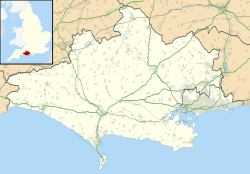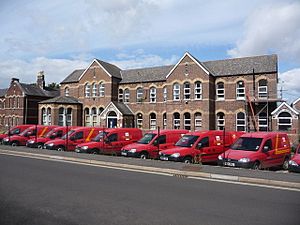The Keep, Dorchester facts for kids
Quick facts for kids The Keep, Dorchester |
|
|---|---|
| Dorchester | |

The Keep
|
|
|
Location within Dorset
|
|
| Coordinates | 50°42′53″N 02°26′37″W / 50.71472°N 2.44361°W |
| Type | Barracks |
| Site information | |
| Operator | |
| Site history | |
| Built | 1877-1881 |
| Built for | War Office |
| In use | 1881-1958 |
| Garrison information | |
| Occupants | Dorset Regiment |
The Keep in Dorchester is a historic building that was once part of a large army base. This base, called barracks, was built around 1880. It housed soldiers from different regiments, which are like special groups of soldiers.
The Keep is the only part of the original barracks that still belongs to the Ministry of Defence. Today, it is a fascinating museum where you can learn about the history of these soldiers. It is also a Grade II listed building, meaning it's an important historical structure.
Contents
Building the Barracks
The Dorchester Depot Barracks were constructed between 1877 and 1881. They were built on the site of an even older army base. This construction was part of big changes in the British army. These changes aimed to have army bases closer to where soldiers lived.
The new barracks had a large parade ground for soldiers to train. Around this area were many buildings. These included the main Keep (which stored weapons), the 'little keep', and blocks for soldiers to live in. There were also separate homes for officers, a gym, offices, and other important buildings.
Soldiers and Regiments
The barracks became the main base for two regiments: the 39th (Dorsetshire) Regiment of Foot and the 75th (Stirlingshire) Regiment of Foot. In 1881, the 39th Regiment joined with the 54th (West Norfolk) Regiment of Foot. Together, they formed a new group called the Dorset Regiment. The Dorchester barracks became their main home.
During World War II, American soldiers used the barracks. They were part of the 701st Ordnance Light Maintenance Company and the 1st Quartermaster Company.
Changes Over Time
In 1958, the Dorset Regiment joined with the Devonshire Regiment. They formed the Devonshire and Dorset Regiment. Their main headquarters then moved to a different base in Exeter.
After this, most of the Dorchester barracks site was redeveloped. Some buildings were knocked down. Others were sold to the local council and the Royal Mail in the 1960s. A tax office was even built on the old parade ground. Only The Keep building remained under military ownership. In 2016, one of the old barrack blocks was sold to be turned into homes.
Across the road from The Keep, there was an even older base called the Cavalry Barracks. Most of this area is still used by the military today. It serves as Dorchester's Army Reserve Centre.
The Keep Military Museum
Today, The Keep is a museum that tells the story of several famous regiments. These include the Devonshire Regiment, the Dorset Regiment, and the Devonshire and Dorset Regiment. You can also learn about the Dorset Yeomanry and the Royal Devon Yeomanry.
The museum is inside the original Keep building. It is a Grade II listed building, which means it's protected for its historical importance. The ground floor still looks much like it did when it was a working barracks.
Exploring the Museum Floors
When you enter the museum, you first go through the old ammunition and powder store. Beyond this is an archway that once led to the rest of the barracks. Nearby, you can see the guardroom and cells where prisoners were kept. One cell is set up to show how it would have looked. In the west tower, there's a special rope system. This was used to lift weapons and supplies to the upper floors.
A spiral staircase takes you to the first floor. Here, the museum displays uniforms, weapons, and equipment. These items show how the regiments changed over their 300-year history.
The second floor features a collection of medals. These include campaign medals and gallantry medals, given for bravery. You can also see displays of small arms and silverware.
On the third floor, you'll find exhibits about the regiments' more recent history. This includes places they have served and important events they took part in. Above this floor are the battlements. From here, you get amazing views of Dorchester town and the countryside around it.




